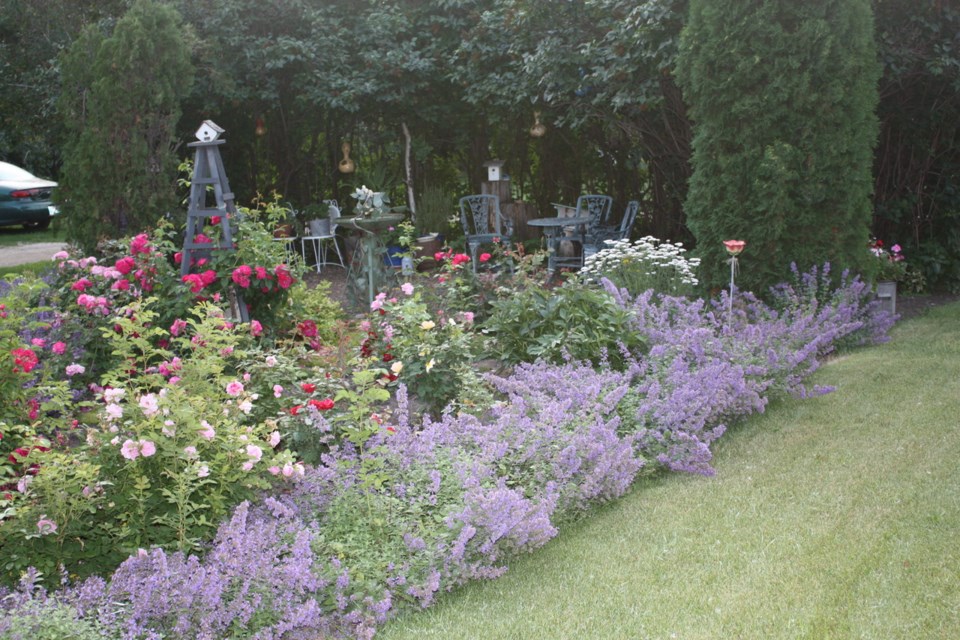[Continued from last week’s article with more perennials that can serve several purposes in our landscapes] With attractive flowers and foliage, and a fairly low height, these are easy to grow and hardy. They can edge a border or path, are at home in a rock garden, and given time, can act as groundcovers in “difficult” areas.
Dwarf baby’s breath (Gypsophila repens)
An old-fashioned flower, baby’s breath is native to the Alps and Pyrenees Mountains of Europe but does very well on the Canadian prairies. The Latin name says it all: Gypsophila means a lover of chalk and refers to its preference for lime-based or alkaline soils, which we have in abundance, while repens refers to its creeping or prostrate form – ideal for a rock garden or edging. Soft, misty clouds of pink or white flowers appear from early to mid-summer above narrow grey leaves about 20 cm (8 in.) in height. But its deep roots make it difficult to transplant once established. It does best in full sun in average well-drained soil. Among the varieties are: ‘Alba’ with white flowers; ‘Rosea’ which is mat-forming with single, rose-pink flowers; and ‘Rosyveil’, developed by Karl Foerster of ornamental grass fame in 1933, with semi-double, pink to white flowers in late summer.
Coral bell Morden hybrids (Heuchera richardsonii x H. sanguinea) were developed at the Brandon and Morden Research Stations. Unlike many of the newer introductions, these are dependably hardy and long-lived. Henry Marshall combined the hardiness of our native coral bells with the beauty of the tender H. sanguinea to develop ‘Brandon Glow’, ‘Brandon Pink’ and ‘Northern Fire’ which were released in 1983. Lynn Collicut continued this work and released ‘Ruby Mist’. All of these are 50-60 cm (20-24 in.) in height, exceptionally hardy, long-lived, with excellent scalloped foliage and flowers with a long blooming period during June and July. ‘Brandon Pink’ has deep coral pink flowers and faintly mottled foliage; ‘Brandon Glow’ has darker pink flowers and distinctly mottled foliage; ‘Northern Fire’ has darker red flowers; and ‘Ruby Mist’ has ruby red flowers and dark green foliage. Place them in full sun to light shade in average well-drained soil. They are easily propagated by spring division.
‘Dropmore Blue’ catmint (Nepeta) is a hybrid developed by Frank Skinner and introduced in 1932. It has spikes of small, tubular blue flowers above oval, grey-green leaves, forming an informal mound of about 40 cm (16 in.). Because the flowers are sterile, it blooms all summer and does not produce unwanted seedlings. Place it in full sun to partial shade in well-drained soil. It is easily propagated by spring division.
Wild strawberry (Fragaria virginiana) is only 30 cm (12 in.) in height with attractive semi-evergreen foliage, white flowers that bloom in early summer and small but exceedingly sweet and tasty red strawberries. Native to the prairies and parklands, it has long been enjoyed by Indigenous Peoples. Easily propagated by separating the plantlets produced by the stolons, it should be planted in full sun to partial shade in average well-drained soil enriched with organic matter.
Soft lungwort (Pulmonaria mollis) differs from most lungworts in that its foliage does not have the variegation that many gardeners have come to expect in lungwort. Its leaves are instead a soft, hairy green and 30-45 cm (12-18 in.) high. The small, bell-shaped flowers are among the earliest, changing from red to blue as they mature. In its favour, it’s more adaptable and much longer lived than most lungworts. It will flourish in full sun to full shade, given an average to moist soil well amended with organic matter. Propagate by division after flowering.
Sara Williams is the author of many books including Gardening Naturally with Hugh Skinner, Creating the Prairie Xeriscape, and with Bob Bors, Growing Fruit in Northern Gardens. She gives workshops on a wide range of gardening topics throughout the prairies.
This column is provided courtesy of the Saskatchewan Perennial Society (SPS; [email protected]). Check our website (www.saskperennial.ca) or Facebook page (www.facebook.com/saskperennial) for a list of upcoming gardening events.




